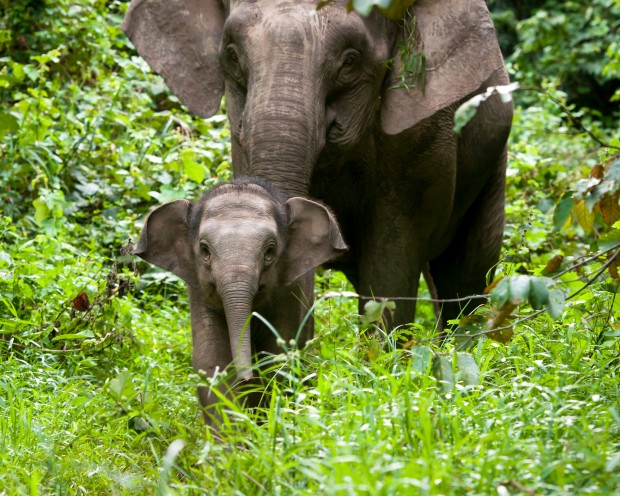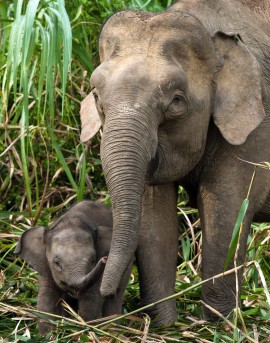Three U.S. Zoos Team Up to Save Rare Borneo Elephants
 Three U.S. zoos announced a new agreement with Borneo-based wildlife organizations today to protect the endangered Borneo pygmy elephant. The first partnership of its kind, the Borneo Elephant Zoo Alliance will provide support for solutions to the frequent and sometimes deadly conflicts between people and elephants on the Southeast Asian island of Borneo.
Three U.S. zoos announced a new agreement with Borneo-based wildlife organizations today to protect the endangered Borneo pygmy elephant. The first partnership of its kind, the Borneo Elephant Zoo Alliance will provide support for solutions to the frequent and sometimes deadly conflicts between people and elephants on the Southeast Asian island of Borneo.
The entire population of the little-known Asian elephant subspecies has been reduced to around 2,000 in the wild, where deforestation — largely driven by logging and palm oil production — threatens their survival. Agricultural workers sometimes kill or injure elephants that raid their plantations, and the clashes can also separate calves from their herds. Houstonians are more familiar with Borneo pygmy elephants’ larger cousin the Asian elephant which are also endangered.
“When you are a local villager and you see your crop completely destroyed overnight, you will not be inspired to save the elephants,” said Dr. Marc Ancrenaz, scientific director for Borneo-based conservation organization Hutan. “Elephants need forests to survive, and people need to convert the forest into other types of land uses, like agriculture, to survive, hence the conflict. If we can’t make peace there, extinction is inevitable.”
The partnership, formed by the Houston Zoo, Oregon Zoo, and Seattle-based Woodland Park, will focus on researching how human-elephant conflicts arise and mitigating those conflicts through community outreach, policy, technology and in some cases, elephant relocation. The work is carried out in Borneo by the Sabah Wildlife Department and conservation organizations HUTAN KOCP and Danau Girang Field Centre.
“The health of the forest is in many ways connected to healthy elephant populations,” said Peter Riger, vice president of conservation and education at the Houston Zoo, which has supported Borneo conservation programming since 2004. “Their need for protected areas and migration corridors literally protects hundreds of species, including amphibians, insects, mammals, birds and many others. In turn, the health of the landscape supports human communities in their livelihoods.”
 The first line of defense in human-elephant conflict is largely a hardware approach. Installing electric fences and training communities to peacefully repel marauding pachyderms are two such tactics. But according to Ancrenaz, elephant-proofing only works in tandem with viable travel alternatives for elephants, such as corridors along waterways. That takes money, but also a detailed understanding of elephant migration patterns, land-use planning and backing from the government — all part of the project’s strategy.
The first line of defense in human-elephant conflict is largely a hardware approach. Installing electric fences and training communities to peacefully repel marauding pachyderms are two such tactics. But according to Ancrenaz, elephant-proofing only works in tandem with viable travel alternatives for elephants, such as corridors along waterways. That takes money, but also a detailed understanding of elephant migration patterns, land-use planning and backing from the government — all part of the project’s strategy.
 “Conservation depends on local and international partnerships,” said Woodland Park Zoo vice president of field conservation Fred Koontz. “A consortium of organizations brings more resources to bear in support of the monumental effort of protecting elephants and their habitats.”
“Conservation depends on local and international partnerships,” said Woodland Park Zoo vice president of field conservation Fred Koontz. “A consortium of organizations brings more resources to bear in support of the monumental effort of protecting elephants and their habitats.”
“This is the first step in a long-term, multi-zoo commitment to protecting Borneo’s wildlife and ecosystems,” said Oregon Zoo conservation and research manager Dr. Nadja Wielebnowski. “We hope this model will both strengthen Malaysia’s resolve to protect wildlife and inspire more conservation organizations to get involved.”
As a zoo-based conservation organization, the Houston Zoo aims to save animals from extinction through strategic partnerships. The zoo’s main conservation focus is to foster and grow our partnerships to strengthen our conservation impact around the world.
Photos courtesy of Marc Ancrenaz/HUTAN.
